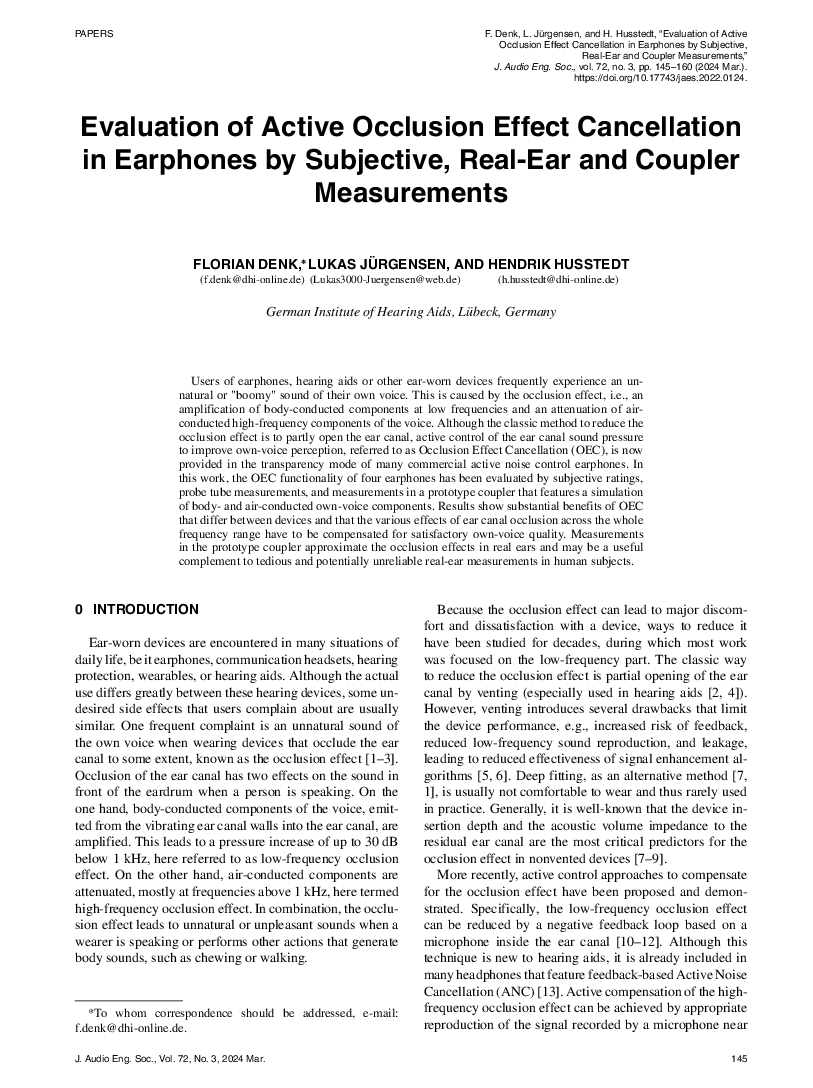Home / Publications / E-library page
You are currently logged in as an
Institutional Subscriber.
If you would like to logout,
please click on the button below.
Home / Publications / E-library page
Only AES members and Institutional Journal Subscribers can download
Users of earphones, hearing aids or other ear-worn devices frequently experience an unnatural or "boomy" sound of their own voice. This is caused by the occlusion effect, i.e., an amplification of body-conducted components at low frequencies and an attenuation of airconducted high-frequency components of the voice. Although the classic method to reduce the occlusion effect is to partly open the ear canal, active control of the ear canal sound pressure to improve own-voice perception, referred to as Occlusion Effect Cancellation (OEC), is now provided in the transparency mode of many commercial active noise control earphones. In this work, the OEC functionality of four earphones has been evaluated by subjective ratings, probe tube measurements, and measurements in a prototype coupler that features a simulation of body- and air-conducted own-voice components. Results show substantial benefits of OEC that differ between devices and that the various effects of ear canal occlusion across the whole frequency range have to be compensated for satisfactory own-voice quality. Measurements in the prototype coupler approximate the occlusion effects in real ears and may be a useful complement to tedious and potentially unreliable real-ear measurements in human subjects.
Author (s): Denk, Florian; Jürgensen, Lukas; Husstedt, Hendrik
Affiliation:
German Institute of Hearing Aids, Lübeck, Germany; German Institute of Hearing Aids, Lübeck, Germany; German Institute of Hearing Aids, Lübeck, Germany
(See document for exact affiliation information.)
Publication Date:
2024-03-06
Import into BibTeX
Permalink: https://aes2.org/publications/elibrary-page/?id=22386
(4362KB)
Click to purchase paper as a non-member or login as an AES member. If your company or school subscribes to the E-Library then switch to the institutional version. If you are not an AES member Join the AES. If you need to check your member status, login to the Member Portal.

Denk, Florian; Jürgensen, Lukas; Husstedt, Hendrik; 2024; Evaluation of Active Occlusion Effect Cancellation in Earphones by Subjective, Real-Ear and Coupler Measurements [PDF]; German Institute of Hearing Aids, Lübeck, Germany; German Institute of Hearing Aids, Lübeck, Germany; German Institute of Hearing Aids, Lübeck, Germany; Paper ; Available from: https://aes2.org/publications/elibrary-page/?id=22386
Denk, Florian; Jürgensen, Lukas; Husstedt, Hendrik; Evaluation of Active Occlusion Effect Cancellation in Earphones by Subjective, Real-Ear and Coupler Measurements [PDF]; German Institute of Hearing Aids, Lübeck, Germany; German Institute of Hearing Aids, Lübeck, Germany; German Institute of Hearing Aids, Lübeck, Germany; Paper ; 2024 Available: https://aes2.org/publications/elibrary-page/?id=22386
@article{denk2024evaluation,
author={denk florian and jürgensen lukas and husstedt hendrik},
journal={journal of the audio engineering society},
title={evaluation of active occlusion effect cancellation in earphones by subjective, real-ear and coupler measurements},
year={2024},
volume={72},
issue={3},
pages={145-160},
month={march},}
TY – paper
TI – Evaluation of Active Occlusion Effect Cancellation in Earphones by Subjective, Real-Ear and Coupler Measurements
SP – 145 EP – 160
AU – Denk, Florian
AU – Jürgensen, Lukas
AU – Husstedt, Hendrik
PY – 2024
JO – Journal of the Audio Engineering Society
VO – 72
IS – 3
Y1 – March 2024